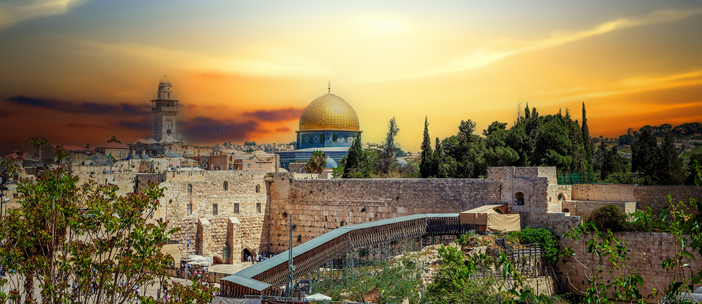For those seeking to trace the footsteps of biblical figures and events, an Israel tour offers an unparalleled opportunity to immerse oneself in the holy land’s rich religious heritage. From the birthplace of Jesus in Bethlehem to the sites of his ministry around the Sea of Galilee, Israel’s tourist attractions encompass hallowed grounds that have shaped the foundations of Christianity.
This article serves as a guide to the must-visit biblical sites during an Israel tour, beginning with the Church of the Nativity in Bethlehem and journeying through Galilee, Nazareth, Jerusalem’s Old City, and the Jordan River, each location offering a profound connection to the stories and teachings that have resonated across centuries.
The Church of the Nativity, Bethlehem
The Church of the Nativity in Bethlehem is one of the oldest surviving Christian churches and a revered site for pilgrims worldwide. Built over the grotto believed to be the birthplace of Jesus, this ancient church dates back to the 4th century AD when Roman Emperor Constantine I and his mother St. Helena commissioned its construction.
A Testament to History
The present structure’s foundation was laid in the 6th century by Byzantine Emperor Justinian, with extensive renovations and decorations added by the Crusaders in the 12th century. Over the centuries, the church has undergone numerous restorations and expansions, reflecting the various rulers and architectural styles that have left their mark on this sacred site.
Today, this historical and spiritual journey continues to inspire many, including visitors from the Evangelical Christian tours of Israel, who come to explore the roots of their faith in this storied landscape. These tours offer a unique perspective on the ancient sites, intertwining biblical history with the complex tapestry of cultural and religious traditions that the region embodies.
The simple yet striking interior features four rows of monolithic columns and 44 white marble pillars, with remnants of frescoes and mosaics adorning the walls. Several tributes to the birth of Christ can be found within, including an altar commemorating his circumcision and the Chapel of St. Joseph.
1. The Grotto of the Nativity
- Located beneath the church, the Grotto of the Nativity is believed to be the exact spot where Jesus was born.
- A 14-pointed silver star encased in white marble marks the scene of the nativity, with burning lamps around it representing the three custodian communities: Roman Catholic, Armenian, and Greek Orthodox.
2. Shared Custody and Traditions
- Since 1852, these three Christian denominations have shared custody of the Church of the Nativity, a testament to its significance across different faiths.
- On Christmas Eve, thousands gather in Manger Square in front of the church to sing carols and celebrate the birth of Christ.
Sea of Galilee and Capernaum
The Sea of Galilee, also known as the Sea of Chinnereth, Sea of Gennesaret, and Sea of Tiberias, is a freshwater lake located in the Jordan Valley, about 60 miles north of Jerusalem. This body of water played a pivotal role in Jesus’ ministry, as it supported a flourishing fishing industry with Capernaum as the center.
The Backdrop of Jesus’ Ministry
1. Significant Events: Many significant events from Jesus’ life and teachings occurred around the Sea of Galilee, including:
- The calling of his disciples, including Peter, Andrew, James, and John
- Calming a violent storm and walking on water
- Feeding the multitudes of 4,000 and 5,000 people
- Teaching the crowds from a boat
2. Appearance After Resurrection: After his resurrection, Jesus appeared to his disciples by the Sea of Galilee, where he restored Peter and affirmed his role as the leader of the apostles.
Capernaum: The Headquarters of Jesus’ Ministry
| Fact | Description |
| Location | An important town on the northwest coast of the Sea of Galilee |
| Significance | A center of the fishing industry and Jesus’ base during his ministry |
| Biblical Events | Site of many of Jesus’ teachings, miracles, and the calling of Matthew the tax collector |
| Archaeological Remains | A church built over Peter’s house and a grand Byzantine synagogue |
The Sea of Galilee and the town of Capernaum were central to Jesus’ earthly ministry, serving as the backdrop for his teachings, miracles, and the recruitment of his disciples. These sites offer a profound connection to the life and work of Jesus, making them essential destinations for those seeking to deepen their understanding of the biblical narrative.
Nazareth
Nazareth, the childhood home of Jesus, holds immense significance in Christian history and is a revered center of pilgrimage. This ancient city, nestled in the hills of Galilee, offers a profound connection to the life and teachings of Jesus Christ.
The Basilica of the Annunciation
1. Largest Basilica in the Middle East
- The Basilica of the Annunciation is the largest church in the Middle East, built on the site where the angel Gabriel announced to Mary that she would bear the Son of God.
- Its impressive dome and portico adorned with mosaics depicting Mary and Jesus, donated by Catholic communities worldwide, make it a breathtaking sight.
2. Mary’s Well and St. Joseph’s Workshop
- Beneath the church lies Mary’s Well, the well where the Virgin Mary was visited by the angel Gabriel.
- Nearby, the Church of St. Joseph’s Workshop marks the site of Joseph’s carpentry workshop and the home of the Holy Family.
Retracing the Footsteps of Jesus
| Site | Significance |
| The Synagogue Church | Built by the Crusaders on the site of the synagogue where Jesus prayed and preached as a young man. |
| Mensa Christi Church | Contains the “Table of the Lord,” the rock where Jesus is believed to have eaten with his disciples after his resurrection. |
| Mount Precipice | The site where an angry mob attempted to push Jesus off a cliff, according to the Gospel of Luke. |
Despite the modern city’s growth over the ancient village, Nazareth remains a treasure trove of biblical sites, allowing visitors to retrace the footsteps of Jesus and immerse themselves in the rich tapestry of Christian history and tradition.
Jerusalem’s Old City
The Western Wall and the Church of the Holy Sepulchre
The Old City of Jerusalem is a captivating tapestry of religious and historical significance, woven with sites revered by Jews, Christians, and Muslims alike. At its heart lies the Western Wall (Kotel HaMaaravi), the last remnant of the Second Jewish Temple and the holiest site in Judaism. Here, the ancient stones bear witness to centuries of fervent prayers and pilgrimage.
1. The Western Wall
- A sacred place of worship for Jews worldwide
- Visitors can slip written prayers into the crevices of the wall
- The plaza before the wall serves as a vibrant gathering space
2. The Church of the Holy Sepulchre
- Believed to be built over the sites of Jesus’s crucifixion and burial
- The Calvary marks the site of the crucifixion
- The Tomb of Christ, or the Edicule, is the revered site of Jesus’s resurrection
The Quarters of the Old City
Jerusalem’s Old City is divided into four distinct quarters, each with its own unique character and religious significance.
| Quarter | Highlights |
| Armenian Quarter | St. James Cathedral, St. Mark’s Chapel, cobblestone streets, Armenian-style ceramic art |
| Christian Quarter | Church of the Holy Sepulchre, Via Dolorosa, Lutheran Church of the Redeemer, Muristan Market |
| Jewish Quarter | Western Wall, King David’s Tomb, Hurva Synagogue, Cardo (ancient Roman street) |
| Muslim Quarter | Dome of the Rock, Al-Aqsa Mosque, vibrant markets, Temple Mount complex |
Sacred Sites and Spiritual Journeys
The Old City of Jerusalem is a tapestry of faith and history, where every stone whispers stories of the past. From the Western Wall to the Church of the Holy Sepulchre, the city’s sacred sites offer profound spiritual experiences for believers and non-believers alike. Whether tracing the footsteps of Jesus along the Via Dolorosa or marveling at the architectural wonders of the Dome of the Rock, a visit to Jerusalem’s Old City is a journey into the heart of humanity’s most cherished religious traditions.
The Jordan River
The Jordan River holds immense significance in biblical history, serving as the site where the ancient Israelites crossed into the Promised Land and where Jesus was baptized by John the Baptist, marking the beginning of his ministry.
A River of Miracles and Traditions
1. The Crossing of the Israelites
- According to the Book of Joshua, the Jordan River’s waters miraculously parted, allowing the Israelites to cross over on dry ground as they entered the land of Canaan.
- This event is commemorated annually during the Feast of Tabernacles, when pilgrims gather at the river’s banks.
2. The Baptism of Jesus
- The Jordan River is revered as the site where Jesus was baptized by John the Baptist, an event that marked the beginning of his public ministry.
- This event is celebrated annually during the Feast of the Epiphany, with pilgrims from around the world gathering to renew their baptismal vows in the river’s waters.
| Significance | Description |
| Biblical Importance | The Jordan River is mentioned over 180 times in the Bible, making it one of the most frequently referenced rivers. |
| Baptismal Tradition | The tradition of baptism by full immersion in the Christian faith began at the Jordan River, following Jesus’ baptism by John the Baptist. |
| Pilgrimage Site | Thousands of pilgrims visit the Jordan River annually, seeking to retrace the footsteps of Jesus and renew their faith through baptism in its sacred waters. |
The Jordan River stands as a testament to the rich biblical heritage of the Holy Land, serving as a site of miracles, traditions, and spiritual renewal for generations of believers.
Conclusion
An Israel tour is a profound journey that allows visitors to retrace the footsteps of biblical figures and events, immersing themselves in the rich tapestry of religious heritage. From the Church of the Nativity in Bethlehem to the Sea of Galilee, the ancient sites of Nazareth, Jerusalem’s Old City, and the Jordan River offer a tangible connection to the stories and teachings that have shaped the foundations of Christianity.
The experiences gained through visiting these sacred sites leave a lasting impact, deepening one’s understanding of the biblical narrative and fostering a sense of spiritual renewal. Whether standing before the Western Wall in Jerusalem or renewing baptismal vows in the Jordan River, an Israel tour is a transformative experience that brings the pages of the Bible to life, creating cherished memories that will endure for a lifetime.





Through individual therapy, group counseling, and experiential activities, residents gain insights, develop coping skills, and build a foundation for long-term sobriety. Our residential Alcohol Rehab offers a structured and supportive environment where individuals can focus on their recovery away from the triggers and stresses of daily life.
This post is one that I find myself referring to very frequently, and it is only right that I acknowledge how much I value it. It is my firm belief that you will continue to provide products that are exceptional in comparison to the overall standard here.
I need a challenger in space waves.